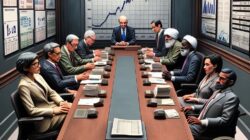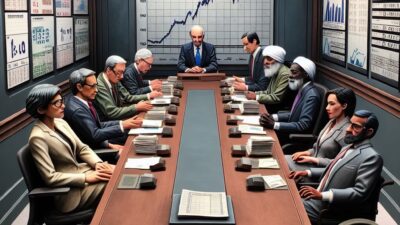The Economic Landscape Facing the Incoming US President
A Robust Economy Awaits
The incoming US president is set to inherit an economy that is not just stable, but robust. As the nation prepares for a leadership transition, the economic indicators paint a picture of strength, with low unemployment rates, solid GDP growth, and significant consumer spending. These factors typically provide a solid foundation for any incoming administration, but the new president faces a complex landscape filled with expectations and potential challenges.
Investor Sentiment: A Double-Edged Sword
While the current economy is thriving, investor sentiment remains cautiously optimistic. Many investors are looking forward to potential economic growth and are eager for the new administration to implement policies that could stimulate further expansion. However, this optimism is tempered by the understanding that maintaining current market highs can be particularly challenging.
The stock market, for instance, has reached unprecedented levels in recent years, and while investors are hopeful that this trajectory will continue, there’s an inherent risk associated with such high valuations. Analysts warn that expecting continuous growth in the face of potential economic headwinds could lead to disappointment.
Challenges on the Horizon
Despite the current economic success, several challenges lurk on the horizon for the new administration. Global economic uncertainties, potential trade tensions, and internal political divisions could all impact the ability to maintain the current economic momentum. Additionally, inflationary pressures present a real threat that could erode consumer purchasing power.
Moreover, the ongoing recovery from the COVID-19 pandemic continues to influence many sectors of the economy, and any resurgence in cases could hamper growth efforts. The new president’s administration may be tasked with balancing public health imperatives with economic recovery measures, a tightrope that can be difficult to navigate.
Focus on Infrastructure and Job Creation
One focal point for the incoming president may be infrastructure investment and job creation. Market experts suggest that large-scale infrastructure projects can provide immediate job opportunities and stimulate economic growth. Such initiatives often receive bipartisan support, making them a potential avenue for the new administration to pursue as a unifying agenda.
Furthermore, addressing the skills gap in the labor market through training and education programs could result in long-term economic benefits. By equipping workers with the skills needed for the jobs of tomorrow, the administration could foster an environment conducive to innovative growth while simultaneously addressing unemployment concerns.
Monetary Policy: A Balancing Act
As the new president steps into office, monetary policy will also be a critical area of focus. The Federal Reserve’s interest rate decisions can have far-reaching implications for economic growth, consumer spending, and investment. While the Fed has been maintaining a low-interest-rate environment to support the economy, any signs of inflation could prompt a change in strategy.
If interest rates rise, borrowing could become more expensive for consumers and businesses, which may dampen spending and investment. The delicate balance between fostering growth and controlling inflation will undoubtedly be a central theme for the incoming administration.
The Role of Technology and Innovation
Another crucial component of economic growth in the coming years will be the role of technology and innovation. As industries increasingly adopt digital solutions, investment in technology could serve as a major growth driver. The incoming president may look to support technological advancements, focusing on sectors such as renewable energy, healthcare advancements, and digital infrastructure.
By prioritizing innovation, the new administration could create a competitive edge for the American economy while addressing pressing societal challenges, such as climate change and public health crises. This approach not only aids in economic growth but also enhances broader societal welfare.
Conclusion: Navigating Uncertainty
The incoming US president steps into a promising yet uncertain economic landscape. While the current state of the economy offers a robust foundation, the challenges ahead require a measured and strategic approach. Investor expectations, global uncertainties, and domestic concerns pose significant hurdles, and navigating this complex reality will require strong leadership and innovative policy responses.
As the administration begins its journey, the focus will likely be on sustaining growth, addressing emerging challenges, and capitalizing on the opportunities inherent in a rapidly evolving global economy. Ultimately, the new administration’s success may hinge on its ability to inspire confidence among investors while taking decisive action to steer the economy in a positive direction for all Americans.












